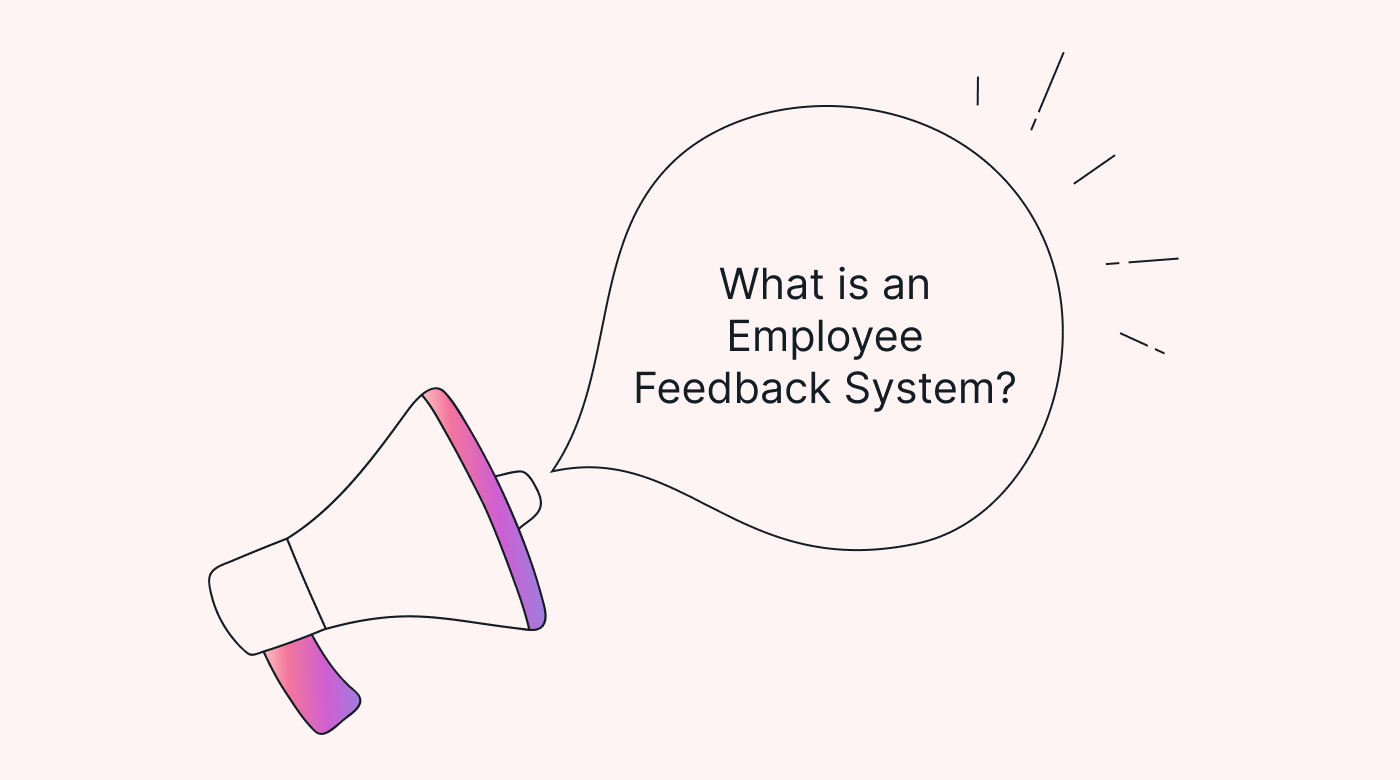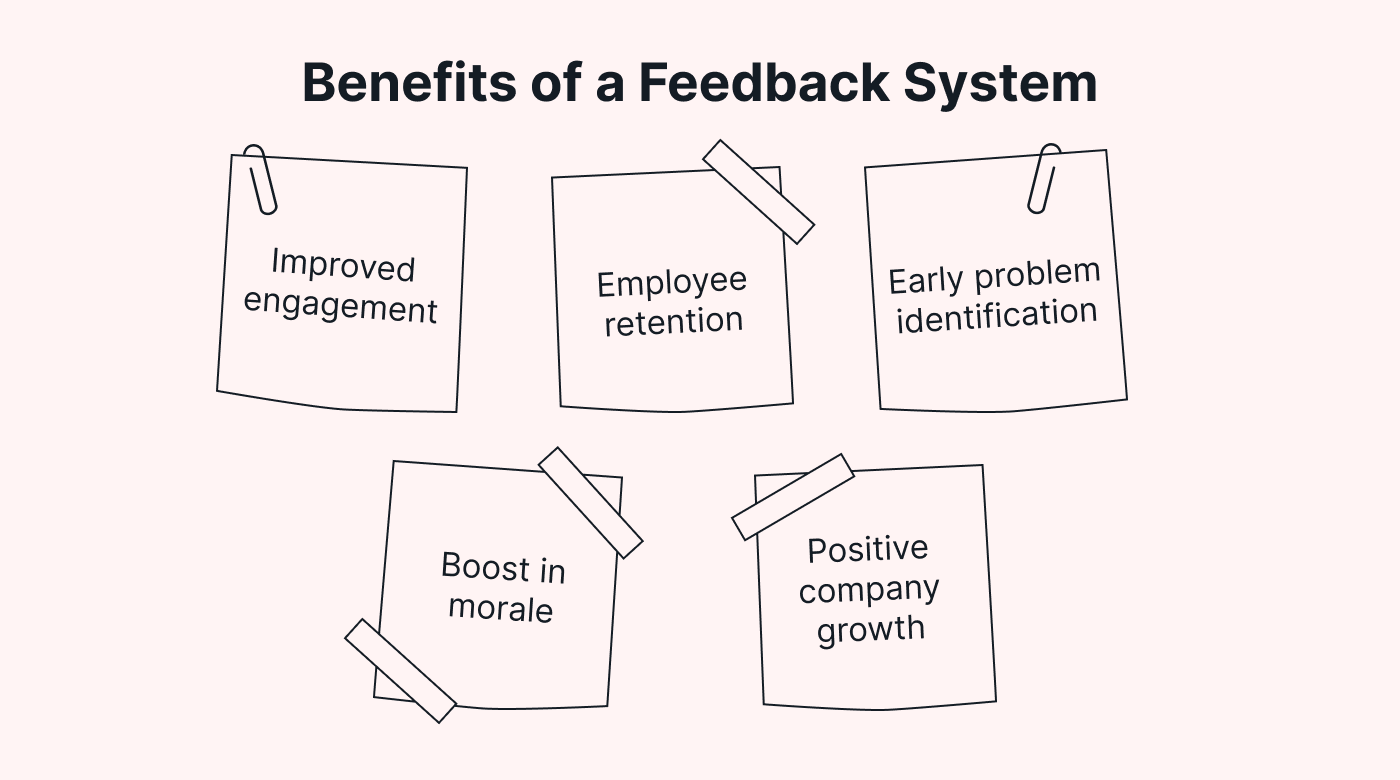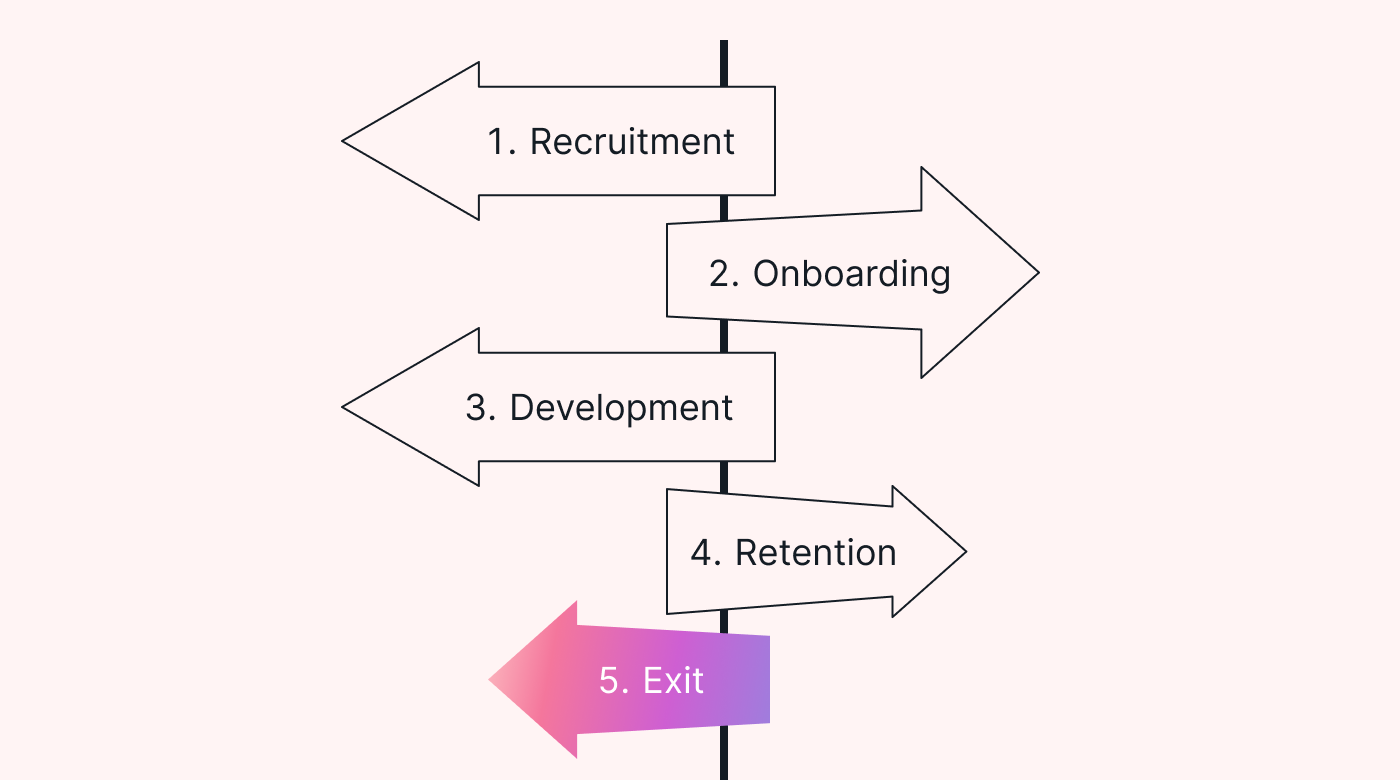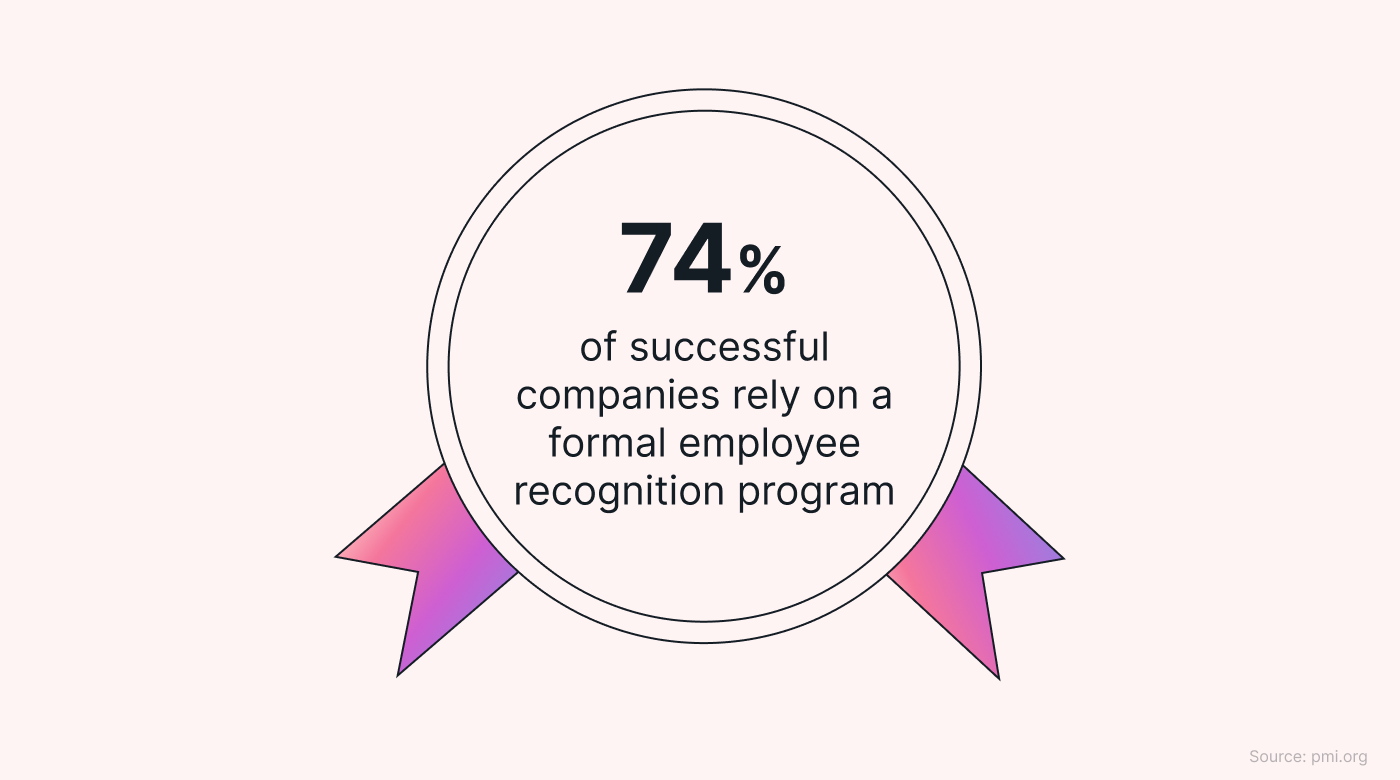You won’t know what your employees are thinking unless you ask them.
Sounds obvious, right?
Yet, many companies still don’t consistently utilize an effective employee feedback system.
Some rely on outdated systems, such as obtaining feedback through occasional surveys, annual performance reviews, or even exit interviews.
These companies miss opportunities to learn not only what their employees think but how their thoughts impact their work on a day-to-day basis — which in turn impacts their productivity and, ultimately, the bottom line.
So don’t be like them.
In this post, we’ll look at the definition of an employee feedback system and review the benefits of having one. Then, we’ll outline the implementation strategies and provide additional tips for success.
Ready to learn more about your employees?
Let’s dive in.
What is an employee feedback system?
An employee feedback system allows employers to gather information about their people.
 |
A feedback system is the specific set of methods and techniques your company uses to determine how your employees think and feel about their workplace. This feedback is also used to evaluate employee performance and set goals.
Feedback systems allow employers to discover their employees’ level of engagement, how they feel about their roles and responsibilities, and even their perceptions about their own job performance and the company as a whole.
These systems also provide a peek into company morale. You may discover areas of strength in your company culture that you can expand upon.
You may also find areas that need improvement that you weren’t aware of. These insights allow you to address issues quickly instead of waiting until they snowball and become harder to resolve.
Now that you know what a feedback system is, read on to see how it can help your business.
What are the benefits of an employee feedback system?
Employee feedback systems provide the following benefits in the workplace:
 |
- Improved engagement and performance. Employees who feel seen and heard are typically more motivated and involved. They feel like they have a stake in the company, so they’re more willing to work toward shared goals. And, overall, this high engagement leads to better job performance.
- Gains in employee retention. Employees who frequently share their ideas and concerns feel more invested in their work, so they’re less likely to quit. On the other hand, people who don’t feel heard don’t have that anchor. They’re not as engaged and might not have a strong reason to stay. Approximately 40% of employees have left jobs due to disengagement or frustration.
- Improved problem-solving. When employees are empowered to share concerns, they are typically willing to highlight problematic areas more readily. This allows managers to address issues early on and prevent them from becoming large-scale problems. It also shows your employees that you take their insights and opinions seriously.
- Boosted morale and company dynamics. A strong, supportive culture is essential for employees. Obtaining feedback and acting upon it builds employee trust and confidence.
 |
- Higher collaboration. Employees who know they will be heard are more likely to speak up. When satisfaction is high in the workplace, 69% report stronger collaboration. For 39%, it also leads to a better work environment.
- More success. Your employees are not the only ones who can benefit from a strong feedback system. Job satisfaction and a strong company culture increase growth, productivity, and customer service.
Given the positive benefits that a feedback system provides, it’s time to think about how to implement such a system.
Strategies for implementing a feedback system
If you’re ready to start gathering employee feedback, here are some strategies for success:
 |
Identify when and how often you’ll gather feedback
Checking in with your employees once a year during performance reviews isn’t enough. Plan to implement a feedback system that starts with the recruitment and onboarding process.
Continue eliciting feedback throughout each employee’s development. Use this as an opportunity to help your employees develop their skills and grow their confidence in the workplace.
You should also gather feedback if an employee leaves the company. Find out their motivation for going elsewhere, and reflect on whether this information will benefit retention efforts.
Select methods for gathering feedback
Plan to implement multiple types of feedback systems. That lets employees communicate in the ways that work for them and leads to a greater response rate.
“Always-on” feedback could take the form of a suggestion box. An online suggestion box allows employees to share their input at any time. If a concern arises, they can fill out a form quickly — and anonymously — to get it off their mind.
You can also foster a company culture of employer availability. A company that’s always on means that management is always ready to listen to concerns and suggestions. Create an open-door policy, whether that’s through your literal office door or through calling, texting, or another form of communication, such as Slack messaging.
Schedule pulse surveys at regular intervals to get a handle on your employees’ perceptions. Decide how frequently you want to send surveys and commit to that schedule. Limit them to three to five questions each, focusing on a specific area of interest. If employees know it won’t take long, they’ll be more likely to complete it.
360-degree feedback provides feedback about an employee’s performance through multiple sources. Ask direct supervisors, coworkers, and customers. If the employee is a manager, talk with their team members for insights. Hearing about their performance from a variety of perspectives will help with goal-setting.
360-degree feedback can be completed through questionnaires, interviews, or other simple forms.
Annual performance reviews give you the chance to have a longer sit-down with each employee. Not only is this a chance for you to give the employee feedback about their job performance, but it’s also an opportunity for you to evaluate areas of concern or for growth.
Decide which type of feedback you are looking for
Several types of feedback could benefit your workplace. Here are just a few:
- Personal growth feedback is directly related to the employee. Think about job performance, engagement, and identifying strengths and weaknesses. This type of feedback generally allows for goal development throughout the year.
Recommended: 360-degree feedback, performance reviews
- Company climate feedback gives you a sense of company culture at any given time. Ask focused questions to assess morale, engagement, and stress levels.
Recommended: Online suggestion box, pulse surveys
- Project progress feedback is critical to ensuring projects are managed successfully. You need a way to check in regularly when you have multiple team members.
Recommended: Always-on feedback, automated systems
If you want to start using an automated system for project management, speak with an expert from Motion today.
Make getting feedback consistent
Now it’s time to put your methods into practice. The key to a successful employee feedback system is consistency.
You have to make getting feedback a priority.
If you implement an online suggestion box, for instance, schedule regular reminders to check it. Nothing will turn employees off faster than knowing their submissions aren’t getting read.
 |
If you opt for pulse surveys, set up automation. Build your survey once, then send it around regularly.
Use the following steps to encourage the always-on approach:
- Schedule regular check-ins.
- Find out if your employees would prefer to meet weekly or monthly.
- Add this non-negotiable time to your schedule.
Employees appreciate knowing that their managers make time for them and care about their concerns.
 |
You should also schedule regular performance evaluations. Try to hold them quarterly or biannually, so employees can receive frequent feedback. This is a chance for both you and them to give and receive input.
Make it safe
If you want honest opinions, you need an environment that’s comfortable to share in. Glenn Smith, a leading business agility leader, emphasizes the importance of psychological safety. Psychological safety encourages workers to redirect conflict and “gang up on the problem itself, not each other.”
Now that you have the strategies you need, read on for tips on how to make them successful.
Act on what you’ve learned
It’s not enough to initiate a new system. Use the following tips to help the system thrive:
- Implement feedback when possible. Look for times in your schedule to gather feedback and consider options. If an employee’s idea or concern is actionable, don’t wait. Address it right away.
- Report back. Once you’ve received feedback, address the concerns. If a concern was made anonymously, you can do this through immediate action.
Make sure your employees understand not only that their concerns have been heard but also how they will be handled.
 |
- Recognize and reward. Rewards go a long way. When employees feel recognized, they are five times more likely to feel connected and engaged with their company.
Offer genuine praise and encouragement. Recognize accomplishments and growth privately and publicly. Determine whether your organization can offer incentives or bonuses.
- Identify opportunities. Now it’s time to determine who’s ready for promotion, advancement, or additional training. You might discover potential management candidates, too.
- Analyze data to inform. Use what you have learned from pulse surveys and always-on strategies to see where your business is performing well and where it’s struggling. Use these strategies to pinpoint and address specific areas of need.
Following these tips will lead to a stronger business and a healthier bottom line.
Use Motion to help you improve employee engagement
Feedback systems are critical to your business’s success.
They provide valuable information about your employees, their perceptions, and how those perceptions translate to their work. It also gives you actionable strategies for improving, leading to better employee retention, greater productivity, and more satisfied customers.
Take the time to implement a system with proven results.
The Motion app builds your schedule, allowing you to create consistent meet-up times or employee drop-in blocks.
Motion also allows you to track projects in one place so your employees know where to go for information and who to contact with questions and updates.
If you are ready to make the most of your business and create maximum engagement, start with your new feedback system today.





